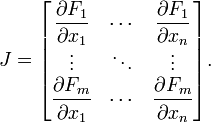Jacobian Matrix
Introduction
In vector calculus, the Jacobian matrix is the matrix of all first-order partial derivatives of a vector-valued function. Specifically, suppose  is a function which takes as input real n-tuples and produces as output real m-tuples. Such a function is given by m real-valued component functions,
is a function which takes as input real n-tuples and produces as output real m-tuples. Such a function is given by m real-valued component functions,  . The partial derivatives of all these functions with respect to the variables
. The partial derivatives of all these functions with respect to the variables  (if they exist) can be organised in an m-by-n matrix, the Jacobian matrix J of F, as follows:
(if they exist) can be organised in an m-by-n matrix, the Jacobian matrix J of F, as follows:

This matrix, whose entries are functions of  , is also denoted by
, is also denoted by  and
and  .
.
(Note that some books define the Jacobian as the transpose of the matrix given above.)
The relation between Jacobian matrix and Gradient:

The Jacobian matrix is important because if the function F is differentiable at a point p=(x1, ... , xn), which is a slightly stronger condition than merely requiring that all partial derivatives exist there, then the derivative of F at p is the linear transformation  represented by the matrix
represented by the matrix  . This linear transformation is the best linear approximation of the function F near the point p.
. This linear transformation is the best linear approximation of the function F near the point p.
In the case m=n, the Jacobian matrix will be a square matrix, and its determinant, a function of x1, ... , xn, is the Jacobian determinant of F. It carries important information about the local behavior of F and can be thought of as a local expansion factor for volumes; it is used when performing variable substitutions in multi-variable integrals since it occurs prominently in the substitution rule for multiple variables.
A Simple Example
Consider the function  given by
given by

Then we have

and

and the Jacobian matrix of F is

and the Jacobian determinant is

References & Resources
- http://en.wikipedia.org/wiki/Jacobian_matrix
Latest Post
- Dependency injection
- Directives and Pipes
- Data binding
- HTTP Get vs. Post
- Node.js is everywhere
- MongoDB root user
- Combine JavaScript and CSS
- Inline Small JavaScript and CSS
- Minify JavaScript and CSS
- Defer Parsing of JavaScript
- Prefer Async Script Loading
- Components, Bootstrap and DOM
- What is HEAD in git?
- Show the changes in Git.
- What is AngularJS 2?
- Confidence Interval for a Population Mean
- Accuracy vs. Precision
- Sampling Distribution
- Working with the Normal Distribution
- Standardized score - Z score
- Percentile
- Evaluating the Normal Distribution
- What is Nodejs? Advantages and disadvantage?
- How do I debug Nodejs applications?
- Sync directory search using fs.readdirSync